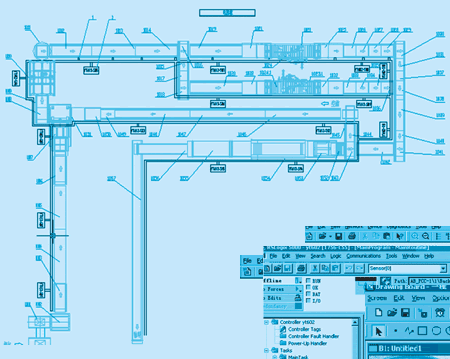在嵌入式系统中,我们通常会要求VxWorks文件尽量小,比如通过串口、软盘或tffs加载VxWorks的时候,如果文件太大,可能无法存储,或加载失败。下面介绍一种利用Tornado和VxWorks自带的deflate和inflate,对VxWorks文件进行压缩和解压缩的技术。希望对大家有所帮助。
1 使用Tornado创建bootable的project,包括应用程序。对VxWorks进行适当的裁减和配置。
2 如果准备将VxWorks存储于硬盘,软盘或tffs上,应该在usrAppInit中使用usrNetEndDevStart和usrNetifConfig启动网络接口。如果存储于tffs上,还要修改usrNetBoot.c中:
if ( (strncmp (sysBootParams.bootDev, "scsi", 4) == 0)
|| (strncmp (sysBootParams.bootDev, "ide", 3) == 0)
|| (strncmp (sysBootParams.bootDev, "ata", 3) == 0)
|| (s
为:
if ( (strncmp (sysBootParams.bootDev, "scsi", 4) == 0)
|| (strncmp (sysBootParams.bootDev, "ide", 3) == 0)
|| (strncmp (sysBootParams.bootDev, "ata", 3) == 0)
|| (strncmp (sysBootParams.bootDev, "tffs", 4) == 0)
|| (strncmp (sysBootParams.bootDev, "fd", 2) == 0))
3 在dos下运行 tornado/host/x86-win32/bin/torvars。
4 进入VxWorks所在的目录,运行:
deflate VxWorks.z。这里我们默认.z文件是压缩文件。
5 如果准备将VxWorks.z存储于硬盘,软盘或tffs上,需要首先创建相应的设备,并用dosFS初始化。如果是通过串口或网络加载VxWorks.z,则需要初始化相应的接口。
6 修改bootConfig.c文件:
a. 在LOCAL STATUS netLoad 函数的 tftpXfer和 ftpXfer这一部分代码结束的地方添加:
if ( strstr(fileName,".z") || strstr(fileName,".Z") )
{
printf("
file %s is compressed, now begin uncompressing...
",fileName);
if (bootLoadModuleInflate(fd, pEntry) != OK)
goto readErr;
}
else if (bootLoadModule (fd, pEntry) != OK)
goto readErr;
b. 在 LOCAL STATUS tffsLoad 函数的 usrTffsConfig和open这一部分代码结束的地方添加:
if ( strstr(fileName,".z") || strstr(fileName,".Z") )
{
printf("
file %s is compressed, now begin uncompressing...
",fileName);
if (bootLoadModuleInflate(fd, pEntry) != OK)
goto readErr;
}
else if (bootLoadModule (fd, pEntry) != OK)
goto readErr;
c. 在 LOCAL STATUS bootLoad 函数之前定义函数 bootLoadModuleInflate的原型:
#define DECOMP_BUF_SIZE (RAM_HIGH_ ADRS - RAM_LOW_ADRS)
#define COMP_BUF_SIZE (DECOMP_BUF_SIZE / 3)
STATUS bootLoadModuleInflate(int zfd, FUNCPTR *pEntry)
{
char *imageBuf = NULL;
char *compBuf = NULL;
int fd = -1;
int rv = ERROR;
int compSize, r;
extern STATUS inflate(char *src, char *dst, int src_size);
if ((compBuf = malloc(COMP_BUF_SIZE)) == NULL)
{
&n
");
goto done;
}
compSize = 0;
while ((r = read(zfd, compBuf + compSize, COMP_BUF_SIZE - compSize)) > 0)
compSize += r;
if (r < 0)
{
printErr("Read failed: errno = %d
", errnoGet());
goto done;
}
if (compSize == COMP_BUF_SIZE)
{
printErr("Compressed image too large
");
goto done;
}
printErr("Uncompressing %d bytes... ", compSize);
if ((imageBuf = malloc(DECOMP_BUF_SIZE)) == NULL)
{
printErr("Not enough memory for decompression buffer
");
goto done;
}
if ((r = inflate(compBuf, imageBuf, compSize)) < 0)
{
printErr("
Uncompress failed
");
goto done;
}
printErr("
Loading image... ");
memDrv();
memDevCreate("mem:", imageBuf, DECOMP_BUF_SIZE);
if ((fd = open("mem:0", O_RDONLY, 0)) < 0)
{
printErr("
Cannot open memory device.
");
goto done;
}
if (bootLoadModule(fd, pEntry) != OK)
{
printErr("
Error loading: errno = %d
", errnoGet());
goto done;
}
&nb sp; printErr("
");
rv = OK;
done:
if (fd >= 0)
close(fd);
if (imageBuf)
free(imageBuf);
if (compBuf)
free(compBuf);
return rv;
}
d. 如果加载不成功,应读懂上一段代码,调整 RAM_HIGH_ADRS 和 RAM_LOW_ADRS的大小。
7 修改 config.h中的启动参数,比如启动设备为tffs=0,0(0,0),文件名为/tffs0/VxWorks.z等等,重新制作bootrom,并写入flash。
8 启动时,修改启动参数,使系统仍然从网络加载VxWorks,这个VxWorks中应该实现了ftp或tftp功能。通过这些功能,把VxWorks.z文件写入存储介质如tffs中。
10 可以首先通过网络启动,把启动文件名改为 VxWorks.z来进行验证压缩和解压缩。
11 以上只是考虑了从网络和tffs来加载VxWorks.z压缩文件,如果从fd, ata等加载,只需在相应地方添加和6.a中相同的代码即可。
12 本方法在ppc850上,利用tffs和网络加载进行了验证,完全适用。






